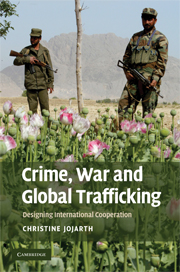Book contents
- Frontmatter
- Contents
- List of figures
- List of tables
- List of abbreviations
- Preface and acknowledgments
- 1 Introduction
- 2 The concept of legalization
- 3 Problem constellation
- 4 Narcotic drugs: UN Convention against Illicit Traffic in Narcotic Drugs and Psychotropic Substances
- 5 Money laundering: the Financial Action Task Force and its Forty Recommendations
- 6 Conflict diamonds: the Kimberley Process Certification Scheme
- 7 Small arms and light weapons: the United Nations Program of Action
- 8 Conclusion
- References
- Index
4 - Narcotic drugs: UN Convention against Illicit Traffic in Narcotic Drugs and Psychotropic Substances
Published online by Cambridge University Press: 02 July 2009
- Frontmatter
- Contents
- List of figures
- List of tables
- List of abbreviations
- Preface and acknowledgments
- 1 Introduction
- 2 The concept of legalization
- 3 Problem constellation
- 4 Narcotic drugs: UN Convention against Illicit Traffic in Narcotic Drugs and Psychotropic Substances
- 5 Money laundering: the Financial Action Task Force and its Forty Recommendations
- 6 Conflict diamonds: the Kimberley Process Certification Scheme
- 7 Small arms and light weapons: the United Nations Program of Action
- 8 Conclusion
- References
- Index
Summary
Today's war on terror is stealing the headlines of another fuzzy war the world is fighting against a non-conventional enemy: the war on drugs. Illicit drugs are a prototypical case of a problem stretching all across the blurred crime–war continuum. On the one hand, narcotics are associated with problems that fall clearly within the crime category, such as crimes committed under the influence of drugs. Not a day passes without the tabloids reporting new sensational stories about a crack addict battering an innocent victim. On the other hand, drugs have also triggered and sustained a number of prominent inter-state and intra-state wars. The tense stand-off between Colombia and its neighbors Venezuela and Ecuador is just the most recent manifestation of the bellicose dimension of the drugs industry. The extra-territorial killing of a senior leader of Colombia's most notorious narco-guerrilla group has led Latin America close to a cross-border war (The Economist 2008).
In this chapter, I will explore the violent side of this half-trillion-dollar business and assess the extent to which the architecture of the international institution created in response – namely the United Nations Convention against Illicit Traffic in Narcotic Drugs and Psychotropic Substances of 1988 – provides the optimal governance structure for dealing with the problem. The starkly contrasting ways and degrees of intensity with which different states are affected by the problem and the scarcity of reliable information on industry trends and on governments' control efforts suggest hard law to be the best design option.
- Type
- Chapter
- Information
- Crime, War, and Global TraffickingDesigning International Cooperation, pp. 92 - 138Publisher: Cambridge University PressPrint publication year: 2009
- 3
- Cited by



